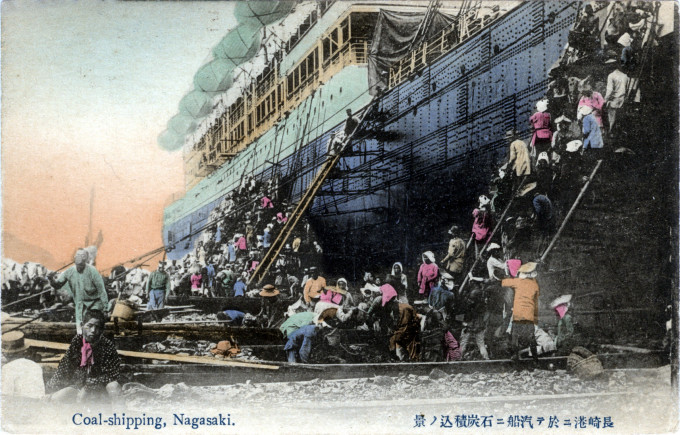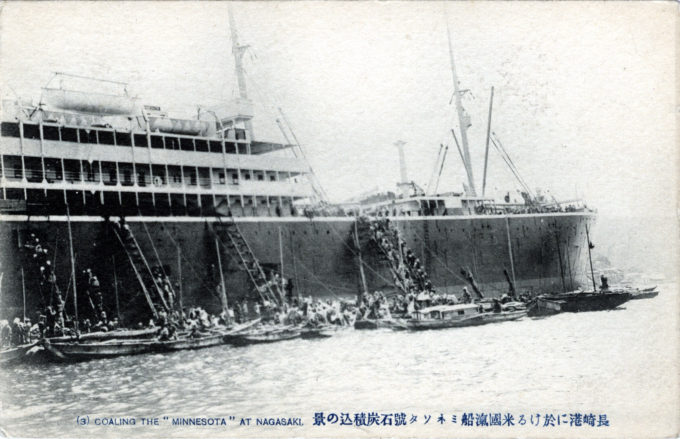“The process of taking on coal [in Nagasaki] was very peculiar. Ladders were placed up the sides of the steamer, relays of men and women were arranged in nine rows, counting from the bottom; coal was placed in baskets and passed up in fire bucket fashion with the utmost quickness and dexterity.
“It continued incessantly until the work was completed. There were more women than men working, and they all wore pointed white handkerchiefs over their heads.”
– Travels in the Far East, by Ellen Mary (Hayes) Peck, 1909
“The entrance to Nagasaki Harbor, although safe of approach, is sometimes difficult for a stranger to make out from a distance, especially in clear weather when the islands blend with the mainland; but on nearer approach, or in slightly hazy weather when the islands appear in relief, the uncertainty is removed. Only the fairway channel northward of Io Jima should be used for entering Nagasaki, although vessels under the guidance of local pilots may use the channels on either side of Koyaki.
“To enter the harbor after passing Hira Se, bring O Sone buoy (conical with red and black horizontal bands) in line with Yone Yama bearing 86°, which leads between the reefs until the extreme of Me gami Bana is in line with Nabekamuri Yama; 59°, which leads between O Sone and Hando Ze. When Kozaki Bana is abeam, the anchorage may be steered for as necessary.
“There is little or no difficulty in entering or leaving Nagasaki at night if the weather be fine, as the light on Io Jima is visible 21 miles and the light on Kagenoo Jima now greatly facilitates night navigation; but should a sailing vessel, from calms or adverse winds, be unable to enter, every endeavor should be made to get inside Takaboko if it be the intention to anchor; for besides the danger of fouling one of the telegraph cables, outside this island the water is inconveniently deep, and it would be preferable to stand off and on until daylight, taking care not to decrease the soundings below 30 fathoms.
“Anchorages
“The harbor everywhere affords secure and sheltered anchorage. Vessels arriving between sunset and sunrise must anchor outside the harbor limits, out of the fairway, excepting those that have appointed berths which may enter at any time.
“Supplies
“Coal: About 3,000 tons of Welsh coal are kept in stock and the supply of native coal is unlimited. It is shipped in baskets from lighters and can be loaded at the rate of 250 tons per hour, if sufficient facilities exist on board ship. Supplies of provisions are plentiful, though dear. Plenty of good water can be obtained. The climate is healthy. Tugs are available.”
– Asiatic Pilot: The Japan Islands, by United States Hydrographic Office, 1910



